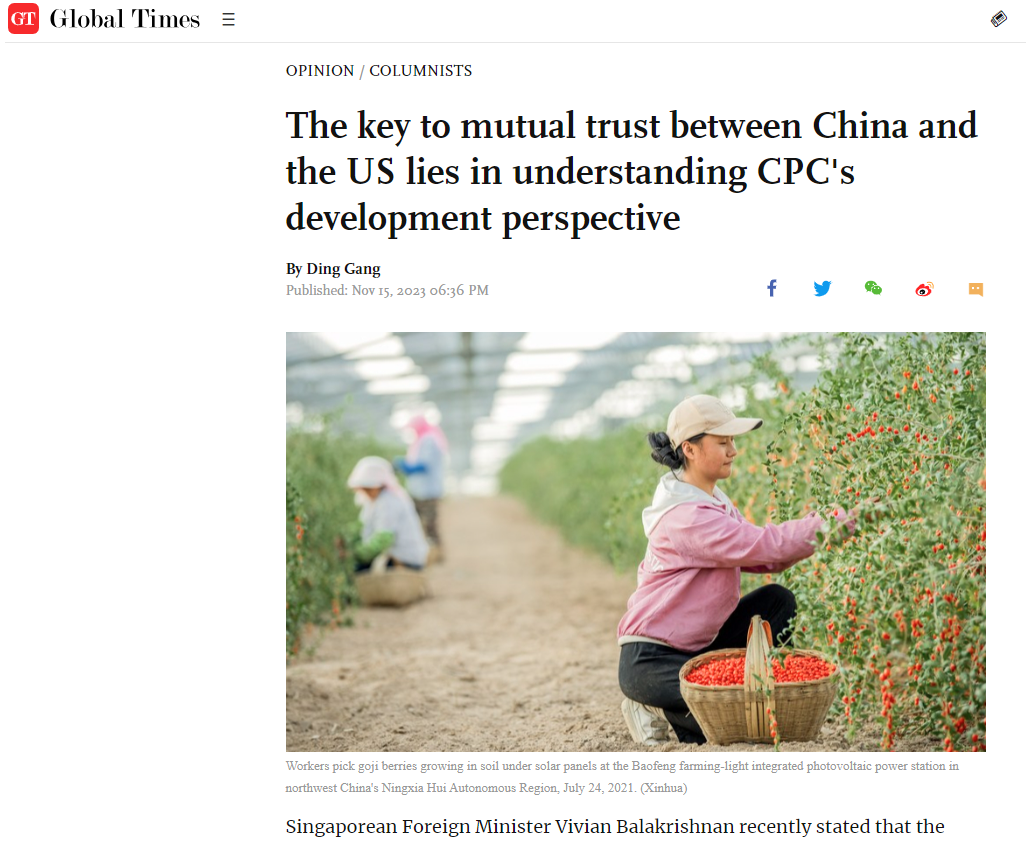LATEST INSIGHTS
Your Present Location: LATEST INSIGHTSDing Gang: The key to mutual trust between China and the US lies in understanding CPC's development perspective
Source: GT Published: 2023-11-15

Singaporean Foreign Minister Vivian Balakrishnan recently stated that the fundamental aspect of the China-US relationship lies in whether there is "strategic trust between the two of them." He hit the nail on the head.
Why has strategic trust between China and the US deteriorated to such an extent? One important reason for the decline in strategic mutual trust between China and the US is the self-created ideological fear that American politicians have toward China. They have fallen into the "trap" of cognition.
To break free from this "trap," it is necessary to have an accurate understanding of why China prioritizes development and why it chooses the path of peaceful development. This often requires looking at specific cases involving China and the Communist Party of China (CPC).
For example, a few years ago, there was a highly-watched TV drama in China called Minning Town, which depicted the story of how the poorest people in the Ningxia Hui Autonomous Region in Northwest China, under the leadership of the CPC, struggled to escape poverty.
I recently visited Minning Town, near Yinchuan, the capital of Ningxia. It is a new city built by thousands of people who migrated from the poorest areas at that time through their own efforts.
In the historical archives, I saw a photo that showed how impoverished the farmers were when they migrated from what was almost a desert over 20 years ago. They were truly destitute! A truck could easily transport the belongings of more than ten families, and almost all of the few pieces of furniture and utensils they had were old and worn out.
In 1996, the CPC Central Committee made a strategic arrangement for 13 relatively developed provinces and cities in eastern China to assist 10 provinces and regions in the western part of the country. Fujian was designated to assist Ningxia. After this, over one million farmers were lifted out of absolute poverty.
In 1997, Xi Jinping, who was then the deputy secretary of the Fujian provincial committee of the CPC, visited the impoverished area of Ningxia for the first time and was deeply shocked by the extreme poverty there, and started making efforts to promote the initiation of "pairing-up" poverty alleviation program between Fujian and Ningxia.
Over 20 years later, Xi visited Ningxia again, this time as Chinese president, and met with the people who had gotten rid of poverty through migration. He said, "No ethnic group should be left behind in the country's fight against poverty, in its building of a moderately prosperous society in all respects, and in its drive toward modernization."
These formerly extremely impoverished rural areas in Ningxia are located on the geographical periphery, where multiple ethnic groups intersect. Ningxia, located in northwest China, is not too far away from the Xinjiang Uygur Autonomous Region, Xizang Autonomous Region and Inner Mongolia Autonomous Region. The connectivity and development of this region are a practical and concrete example of China's concept of modernization.
This is just one small story among the thousands of development stories in China, which reflects the governance approach that "development is the master key to solving all problems."
Without the leadership and governance of the CPC, such development would not have been possible. Moreover, such large-scale poverty alleviation has not burdened the world but has instead helped China become a major engine driving the global economy.
Of course, sustainable development remains a daunting challenge, and the CPC and the Chinese government will continue to focus on it in the future. The key to this will be how to maintain sustainable economic development and benefit more ordinary people.
If Washington is afraid of such a development perspective, it is their strategic vision that is flawed.
Some politicians and experts in the US now always view China through the lens of ideology. The strategic goals they set are aimed at preventing CPC-led China from undermining their so-called world order. Behind this lies a political dividing line, which is that China's development does not meet their standards, the development path is wrong and it will inevitably challenge the world order. This is a fundamental problem that leads to a lack of strategic trust between China and the US.
If the CPC's leadership can successfully achieve such a grand poverty alleviation goal, it inevitably demonstrates the correctness of its chosen path and the effectiveness of its governance approach.
When observing a development path, it is important to consider who is guiding and governing, but more importantly, whether it can lead impoverished people to prosperity and benefit the general population. This is common sense and is needed to understand the development of any country. However, this common sense has been distorted by the US and the West, turning it into the belief that anything done by the Communist Party is wrong and may pose a threat.
The TV drama Minning Town has now been released in English and is being broadcast globally. I sincerely suggest that politicians in Washington, while continuing to hype up the "threat" posed by the CPC, also take some time to watch this series, especially the members of the Select Committee on the Strategic Competition Between the United States and the Chinese Communist Party. If they are not even aware of this well-known story in China, how can they understand whether the competition between the US and China can be successful?
The author is a senior editor with the People's Daily, and currently a senior fellow with the Chongyang Institute for Financial Studies at Renmin University of China.
Key Words: Ding Gang, the US, CPC























































































 京公网安备 11010802037854号
京公网安备 11010802037854号





